This is Yonaguni - これは与那国
Please refer to other entries for the full story.
PART 1 Across the Sea to Yonaguni - 与那国まで海を渡って
PART 2 This is Yonaguni - これは与那国
PART 3 Pacific Atlantis - 与那国の海底遺跡
We grabbed a couple of hours sleep after our 4am arrival at Sonai in Yonaguni, but we were so paranoid about getting busted that we were up again at first light. Fortunately, nothing out of the ordinary seemed to be happening. The town was quiet; only the wind blew steadily. We called our Iriomote friends at 6am to tell them we’re okay, knowing they’d be up getting ready for another day of guiding tourists. And although we were planning to take the ferry back the following day, we thus began what was to be, interestingly enough, a rather sleepless and foodless six days on Yonaguni.

与那国の祖内に深夜四時頃着いた後、少し眠っていました。しかし、前日のパラノイアによって、もう六時に目が覚めました。でも村では、何も異常な事は無かった、ただ風はまだまだ強く吹いていました。もうこの日のガイヂングの準備で起きている西表の友達に、「無事に着いた」の電話を掛けました。それで、翌日のフェリーで帰る予定だったのに、与那国の食事をあまり食べない、睡眠時間もあっまりないの私達の六泊五日の滞在が始まりました。
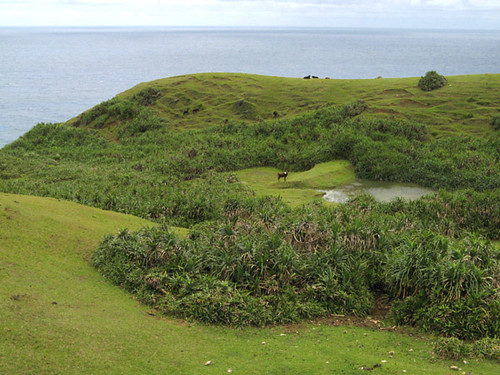
Large tracts of Yonaguni Island serve as pastureland for cows and horses, both of diminutive size as if matched to the island itself. The sea is never too far away.
与那国にある広い牧場の景色。自由のある喜んだ牛も馬も、島の小さなサイズに合わせた大きさです。海は、いつも近い。
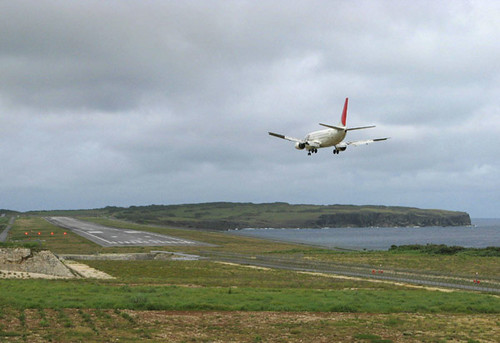
The Yonaguni airport serves as a convenient access point for tourists, yet only a few thousand visit here every year. The alternative is the 4-hour ferry which only runs twice a week, or of course, the sea kayak which sails at one’s own discretion.
与那国空港は、観光客に便利な島のアクセスポイントです。しかも、一年間は数千人しか訪れていない。フェリーにも乗れるけど、一周に二便だけで、石垣まで四時間かかります。後はカヤックも、マイペースで行ける。
By mid-morning the town policeman walked by our stashed kayaks with no particular reaction, so we forgot about all danger and rented a motorbike to give the 27km circuit around the island a spin. There was much scenery to see, usually dominated by the uninterrupted horizon of the sea. The island’s symmetrical shape gave the impression of being on a giant ship, with Cape Agari in the east as the bow, and Cape Iri in the west the stern. At the top of the tall cliffs of both capes there are lighthouses, and waves were breaking on reefs far below. To avoid some of the cliffs, the perimeter road would wind through the hills for a while, cutting alternately through woods, pastures, and fields, then break out into fantastic stretches along the rocky coastline with the wide Pacific beyond. It was simple but spectacular scenery and we liked it at once.
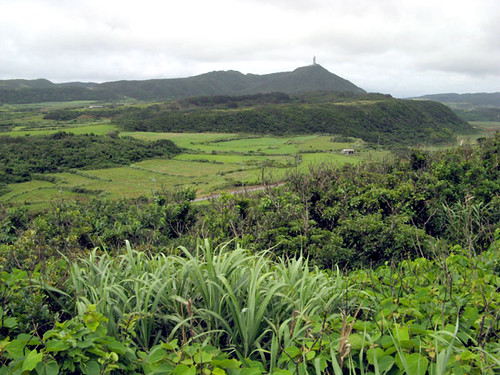
Yonaguni scenery is a rich green mixture of hills, pasture, and fields.
与那国の景色は、深い緑の山、牧場、や畑から成す。
朝九時ごろ村の警察官がビーチの近くで置いていたカヤックを気にしないように歩いて通ったから、もう緊張する事は無いだろうと思いながら、村に出ました。そこで道路で島の27キロの一周をしようとして、バイクをレンタルしました。島の景色は綺麗でした。どこでも島の緑の山やドラマチックな岩の後ろに、広い海の水平線。島の対称的な形は、東崎(あがりざき)は、バウで、西崎(いりざき)は、スターンとして、太平洋に浮かんでいる巨大な船が思い浮かびました。格岬の頂上に、灯台があって、眺めは素晴らしかった。高い崖の下、波は岩に当たり続けていました。周囲の道は、海岸の岸壁を避ける為に、たまに島内へ向けて、山の森、牧場や畑を通ると、又突然岩の海岸と海が現れてきます。単純だけど、精妙な景色でした。
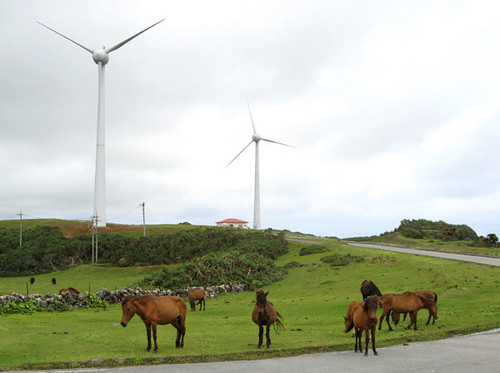
Local wildlife loitering about Agarizaki’s wind turbines, all to be admired by passing tourists.
The turbines provide useful electricity, but not without problems. Last year’s typhoon blew the blades off one machine; these flew the better part of a kilometer, coming to rest on a beach below the coastal cliffs.
東崎の風力発電所の近くに、与那国の代表の「んま」が見えます。とてもおとなしいです。しかし、島の自然は逆に厳しい。去年の台風によって、発電機のプロペラーが外れて岸壁のしたのビーチまで、数百メートル飛ばされたそうです。
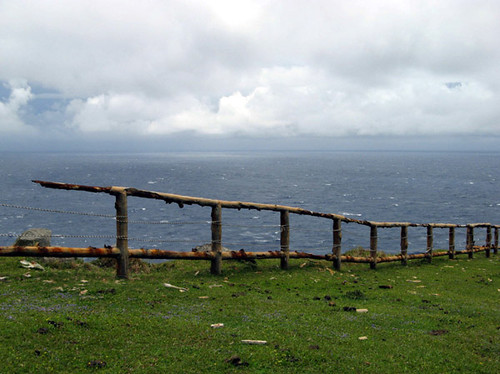
Along Agarizaki’s clifftop, this steel and concrete railing too is no match for the salty winds that blow from the open Pacific. Here and elsewhere, nature seems constantly at odds with man’s efforts to tame it.
東崎の絶壁の上にある鉄柵も、太平洋からの塩っぽい風に耐えられない。人間と大自然の闘いは、ここでも続いているようです。
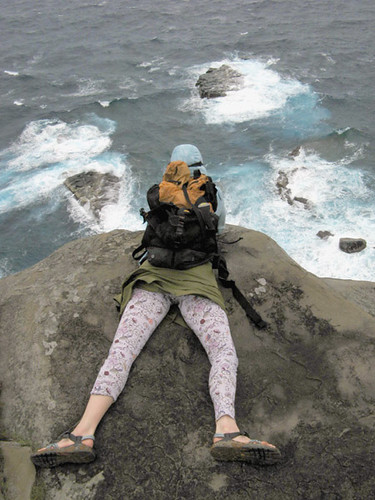
Lying on the very prow of the island, Leanne looks down upon the pounding surf sixty meters below. Rounding the cape by kayak in these conditions would not be easy.
東崎の間天辺から、里杏は下の荒れている海を望みます。こんな状況で、カヤックで回るのは大変そう。
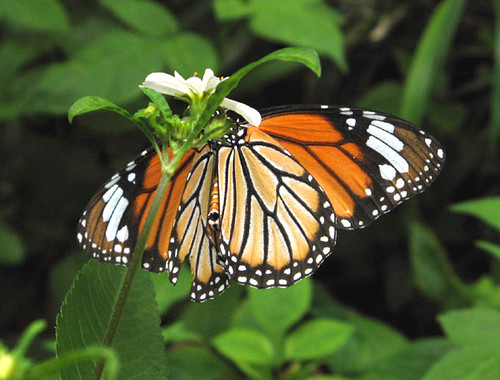
The island’s woods teem with colorful butterflies like in some botanical garden.
まるで植物園のように、島の林で、たくさんの綺麗な蝶が見えます。
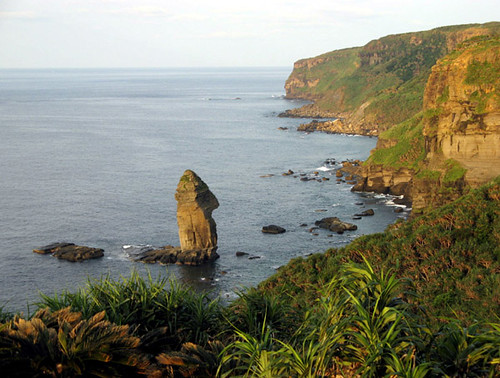
Yonaguni’s southeast coast is perhaps best known for its cliffy scenery; the phallic Tategami Rock the island’s most famous natural icon.
与那国の南東海岸で、代表的な「立神」と言う岩があります。
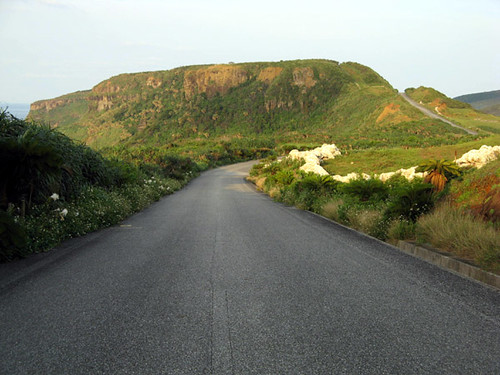
The scenic coastal road winds among the island’s cliffs and hills.
海岸沿いの道路は、こんな素晴らしい景色が続いています。

Stunned by the island’s natural beauty, not to mention the previous night’s experiences on the sea, the Gumbies pose for a tourist shot.
島の景色や昨夜の航海による呆れ顔のGumbiesは、立神海岸で、観光客っぽいポーズをしている。
By 3pm the bike was due to be returned and we ambled back to our kayaks. It was time to move over a few kilometers to the neighboring town of Kubura where after staying the night, we could catch the ferry. The sea along the north coast was windy but protected from swell by the island itself, so the going was easy. At Kubura, with fears of the authorities allayed, we set up camp at the port not far from the waiting ferry, and had a delicious dinner in a seafood restaurant that caters mostly to scuba-diving tourists, who are the island’s most frequent visitors.
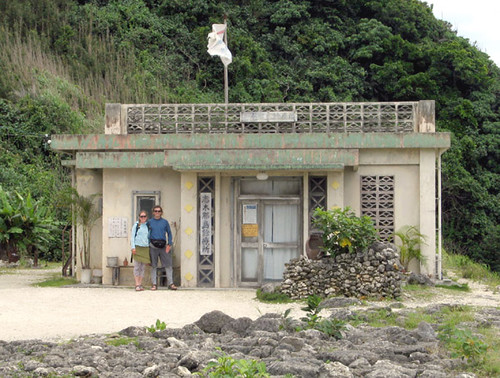
Featured prominently in a popular Japanese TV drama about a young Tokyo doctor who came to work on an isolated island, this half-derelict concrete building is actually the reason why a good many of the island’s visitors come here at all. On request of friends back home, we too snapped the requisite picture.
テレビドラマの「ドクターコトウ診療所」で有名になったこの古いコンクリートの建物。島の観光客の大部分は、これを見るだけに訪れて来るそうです。私達も、天草の友達に誘って、この写真を取った。
午後三時、バイクを返した後、久部良と言う隣の港に移動する時間になりました。そこで一泊キャンプしてから、フェリーに乗る予定がありました。北海岸の海上は風が強かったが、波は島に防がれて進行は順調でした。久部良で、停泊したフェリーに直ぐ近くテントを張って、村の小さな海の幸のレストランでごちそう食べました。
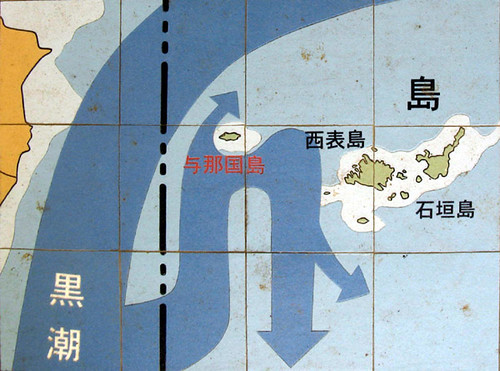
An excerpt from a large mosaic map on the floor of the gazebo at Irizaki, Japan’s westernmost land, which shows helpfully (and more or less accurately, as far as we can tell) the motion of the sea currents around western Japan.
日本最西端の西崎に有る東屋の床に、この地図が有った。西日本の海の流れを、ある程度精確に表します。
Before going to bed we made plans to paddle out to the ‘undersea ruins’ at the island’s southern extremity early enough in the morning to be back for the 10am ferry. But the weather at 4am was blowing and rainy, precipitating a key decision. We would stay five more days until the next ferry run. We’d be sacrificing an exploration of the coral reefs around Ishigaki and Iriomote, but this island, small as it was, seemed to offer enough to keep us busy. In particular, the undersea ruins, shrouded in mystery and described only by sources of questionable objectivity, seemed worthy of more than a perfunctory, hurried look.
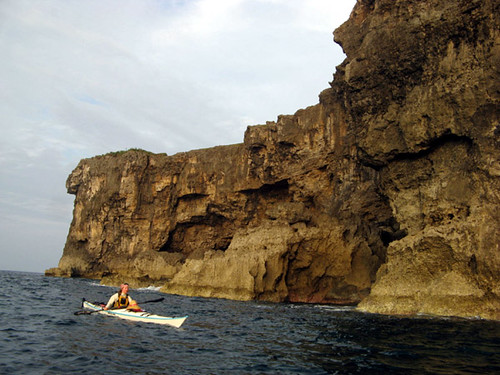
On the way to Kubura, Leanne rounds Cape Umabana with its tall and bizarre limestone cliffs. True to its name (Horse’s Nose), ungulates could be seen grazing precariously on the very edges of the cliff.
久部良の途中、馬鼻崎の奇岩怪石を通ります。岬の名前に確実、崖っぷちに草を食っている「んま」が見えました。
寝る前翌日の予定を立てました。フェリーに乗るまえ、与那国の有名な「海底遺跡」を見に行こうと決めました。しかし、予定した朝四時に天気は雨と風でひどくて、止めました。変わりに、次のフェリーの便までの五日間与那国に滞在しようと決定した。石垣や西表の周りのリーフを探検する予定があったのに、この島も、小さいのに、たくさんの面白い物がありそうでした。特に遺跡は、有名なのに、科学的な説明より研究もなさそうですから、お座なりな一覧より、もうちょっと丁寧に見たかったのですから。
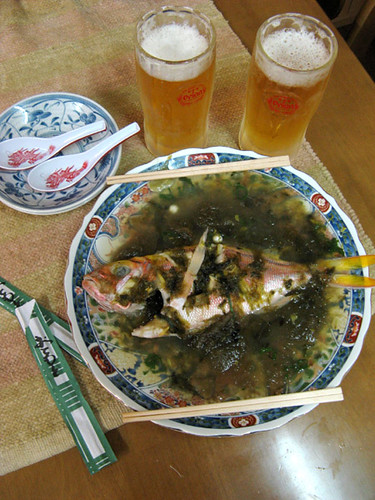
At Kubura’s tiny restaurant “Hiko”, this fish in seaweed sauce was the first dish of a three-course, impeccably delicious dinner, accompanied by ample amounts of Okinawa’s own Orion Beer. A fresh vegetable salad with juicy sashimi and fish eggs followed, while fried rice covered with melted cheese capped off our happy stomachs. Highly recommended, especially if you have worked up an appetite diving or kayaking.
久部良のちっちゃい「彦」と言う海の幸レストランで、すごく美味しい夕ご飯を食べました。オリオンビールと共に、三つの皿があって、これはその一つのです。後は刺身といくらのサラダやチーズに被せたご飯もあった。お勧めです!
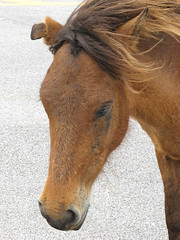
与那国の「んま」
PART 1 Across the Sea to Yonaguni - 与那国まで海を渡って
PART 2 This is Yonaguni - これは与那国
PART 3 Pacific Atlantis - 与那国の海底遺跡
We grabbed a couple of hours sleep after our 4am arrival at Sonai in Yonaguni, but we were so paranoid about getting busted that we were up again at first light. Fortunately, nothing out of the ordinary seemed to be happening. The town was quiet; only the wind blew steadily. We called our Iriomote friends at 6am to tell them we’re okay, knowing they’d be up getting ready for another day of guiding tourists. And although we were planning to take the ferry back the following day, we thus began what was to be, interestingly enough, a rather sleepless and foodless six days on Yonaguni.

与那国の祖内に深夜四時頃着いた後、少し眠っていました。しかし、前日のパラノイアによって、もう六時に目が覚めました。でも村では、何も異常な事は無かった、ただ風はまだまだ強く吹いていました。もうこの日のガイヂングの準備で起きている西表の友達に、「無事に着いた」の電話を掛けました。それで、翌日のフェリーで帰る予定だったのに、与那国の食事をあまり食べない、睡眠時間もあっまりないの私達の六泊五日の滞在が始まりました。

Large tracts of Yonaguni Island serve as pastureland for cows and horses, both of diminutive size as if matched to the island itself. The sea is never too far away.
与那国にある広い牧場の景色。自由のある喜んだ牛も馬も、島の小さなサイズに合わせた大きさです。海は、いつも近い。

The Yonaguni airport serves as a convenient access point for tourists, yet only a few thousand visit here every year. The alternative is the 4-hour ferry which only runs twice a week, or of course, the sea kayak which sails at one’s own discretion.
与那国空港は、観光客に便利な島のアクセスポイントです。しかも、一年間は数千人しか訪れていない。フェリーにも乗れるけど、一周に二便だけで、石垣まで四時間かかります。後はカヤックも、マイペースで行ける。
By mid-morning the town policeman walked by our stashed kayaks with no particular reaction, so we forgot about all danger and rented a motorbike to give the 27km circuit around the island a spin. There was much scenery to see, usually dominated by the uninterrupted horizon of the sea. The island’s symmetrical shape gave the impression of being on a giant ship, with Cape Agari in the east as the bow, and Cape Iri in the west the stern. At the top of the tall cliffs of both capes there are lighthouses, and waves were breaking on reefs far below. To avoid some of the cliffs, the perimeter road would wind through the hills for a while, cutting alternately through woods, pastures, and fields, then break out into fantastic stretches along the rocky coastline with the wide Pacific beyond. It was simple but spectacular scenery and we liked it at once.

Yonaguni scenery is a rich green mixture of hills, pasture, and fields.
与那国の景色は、深い緑の山、牧場、や畑から成す。
朝九時ごろ村の警察官がビーチの近くで置いていたカヤックを気にしないように歩いて通ったから、もう緊張する事は無いだろうと思いながら、村に出ました。そこで道路で島の27キロの一周をしようとして、バイクをレンタルしました。島の景色は綺麗でした。どこでも島の緑の山やドラマチックな岩の後ろに、広い海の水平線。島の対称的な形は、東崎(あがりざき)は、バウで、西崎(いりざき)は、スターンとして、太平洋に浮かんでいる巨大な船が思い浮かびました。格岬の頂上に、灯台があって、眺めは素晴らしかった。高い崖の下、波は岩に当たり続けていました。周囲の道は、海岸の岸壁を避ける為に、たまに島内へ向けて、山の森、牧場や畑を通ると、又突然岩の海岸と海が現れてきます。単純だけど、精妙な景色でした。

Local wildlife loitering about Agarizaki’s wind turbines, all to be admired by passing tourists.
The turbines provide useful electricity, but not without problems. Last year’s typhoon blew the blades off one machine; these flew the better part of a kilometer, coming to rest on a beach below the coastal cliffs.
東崎の風力発電所の近くに、与那国の代表の「んま」が見えます。とてもおとなしいです。しかし、島の自然は逆に厳しい。去年の台風によって、発電機のプロペラーが外れて岸壁のしたのビーチまで、数百メートル飛ばされたそうです。

Along Agarizaki’s clifftop, this steel and concrete railing too is no match for the salty winds that blow from the open Pacific. Here and elsewhere, nature seems constantly at odds with man’s efforts to tame it.
東崎の絶壁の上にある鉄柵も、太平洋からの塩っぽい風に耐えられない。人間と大自然の闘いは、ここでも続いているようです。

Lying on the very prow of the island, Leanne looks down upon the pounding surf sixty meters below. Rounding the cape by kayak in these conditions would not be easy.
東崎の間天辺から、里杏は下の荒れている海を望みます。こんな状況で、カヤックで回るのは大変そう。

The island’s woods teem with colorful butterflies like in some botanical garden.
まるで植物園のように、島の林で、たくさんの綺麗な蝶が見えます。

Yonaguni’s southeast coast is perhaps best known for its cliffy scenery; the phallic Tategami Rock the island’s most famous natural icon.
与那国の南東海岸で、代表的な「立神」と言う岩があります。

The scenic coastal road winds among the island’s cliffs and hills.
海岸沿いの道路は、こんな素晴らしい景色が続いています。

Stunned by the island’s natural beauty, not to mention the previous night’s experiences on the sea, the Gumbies pose for a tourist shot.
島の景色や昨夜の航海による呆れ顔のGumbiesは、立神海岸で、観光客っぽいポーズをしている。
By 3pm the bike was due to be returned and we ambled back to our kayaks. It was time to move over a few kilometers to the neighboring town of Kubura where after staying the night, we could catch the ferry. The sea along the north coast was windy but protected from swell by the island itself, so the going was easy. At Kubura, with fears of the authorities allayed, we set up camp at the port not far from the waiting ferry, and had a delicious dinner in a seafood restaurant that caters mostly to scuba-diving tourists, who are the island’s most frequent visitors.

Featured prominently in a popular Japanese TV drama about a young Tokyo doctor who came to work on an isolated island, this half-derelict concrete building is actually the reason why a good many of the island’s visitors come here at all. On request of friends back home, we too snapped the requisite picture.
テレビドラマの「ドクターコトウ診療所」で有名になったこの古いコンクリートの建物。島の観光客の大部分は、これを見るだけに訪れて来るそうです。私達も、天草の友達に誘って、この写真を取った。
午後三時、バイクを返した後、久部良と言う隣の港に移動する時間になりました。そこで一泊キャンプしてから、フェリーに乗る予定がありました。北海岸の海上は風が強かったが、波は島に防がれて進行は順調でした。久部良で、停泊したフェリーに直ぐ近くテントを張って、村の小さな海の幸のレストランでごちそう食べました。

An excerpt from a large mosaic map on the floor of the gazebo at Irizaki, Japan’s westernmost land, which shows helpfully (and more or less accurately, as far as we can tell) the motion of the sea currents around western Japan.
日本最西端の西崎に有る東屋の床に、この地図が有った。西日本の海の流れを、ある程度精確に表します。
Before going to bed we made plans to paddle out to the ‘undersea ruins’ at the island’s southern extremity early enough in the morning to be back for the 10am ferry. But the weather at 4am was blowing and rainy, precipitating a key decision. We would stay five more days until the next ferry run. We’d be sacrificing an exploration of the coral reefs around Ishigaki and Iriomote, but this island, small as it was, seemed to offer enough to keep us busy. In particular, the undersea ruins, shrouded in mystery and described only by sources of questionable objectivity, seemed worthy of more than a perfunctory, hurried look.

On the way to Kubura, Leanne rounds Cape Umabana with its tall and bizarre limestone cliffs. True to its name (Horse’s Nose), ungulates could be seen grazing precariously on the very edges of the cliff.
久部良の途中、馬鼻崎の奇岩怪石を通ります。岬の名前に確実、崖っぷちに草を食っている「んま」が見えました。
寝る前翌日の予定を立てました。フェリーに乗るまえ、与那国の有名な「海底遺跡」を見に行こうと決めました。しかし、予定した朝四時に天気は雨と風でひどくて、止めました。変わりに、次のフェリーの便までの五日間与那国に滞在しようと決定した。石垣や西表の周りのリーフを探検する予定があったのに、この島も、小さいのに、たくさんの面白い物がありそうでした。特に遺跡は、有名なのに、科学的な説明より研究もなさそうですから、お座なりな一覧より、もうちょっと丁寧に見たかったのですから。

At Kubura’s tiny restaurant “Hiko”, this fish in seaweed sauce was the first dish of a three-course, impeccably delicious dinner, accompanied by ample amounts of Okinawa’s own Orion Beer. A fresh vegetable salad with juicy sashimi and fish eggs followed, while fried rice covered with melted cheese capped off our happy stomachs. Highly recommended, especially if you have worked up an appetite diving or kayaking.
久部良のちっちゃい「彦」と言う海の幸レストランで、すごく美味しい夕ご飯を食べました。オリオンビールと共に、三つの皿があって、これはその一つのです。後は刺身といくらのサラダやチーズに被せたご飯もあった。お勧めです!

与那国の「んま」
Labels: kayak expedition シーカヤック遠征


2 Comments:
ok, i have been scanning back through the blog trying to get the whole Yonaguni story.
I hate to sound hyberbolic, but it has been a riveting read. I hope you'll post more.
So - if you were spotted by a freighter on the sea, what would happen? I thought maybe you were steering clear of them to avoid being run over, or getting caught up in the wake, but it seemed you wanted to avoid being spotted. Is this illegal?
You guys are my new heroes. I gotta tell my friend this story.
The whole post about the sea crossing was white knuckle for me. I kept jumping up and down from the computer to act it out for my girlfriend, and then sitting down to read some more.
Damn - I thought I was a badass for flying to Yonaguni to scuba dive. I must come to terms with a new reality.
One small suggestion to consider. What about adding labels to your blog, and a label list?
Just because I didn't know where the Yonaguni story resumed (it seems interspersed with other blog topics).
By Andre Rivas, at 3:16 am
Andre Rivas, at 3:16 am
Hi Andre,
sorry for the super-late response to your note...i wonder if you will ever read it! somehow it has escaped my attention though we did add labels to our blog to bring the story (and other) a bit more together, according to your suggestion. it's a bit of a deficiency in this blog format that it's not easy to make a browseable index of everything.
anyways, we are thrilled that you liked the story; once again we must say that it's readers like you that come out of nowhere that make us put forth the effort to blog in the first place.
as for the freighters on the sea, no, what we were doing is not illegal, but if we were spotted a bit of a circus could happen. we have no way of predicting what a sea captain would think of seeing us and it is kind of likely they would call the coast guard or something. then we'd get helicopters buzzing around us and so on for no particular reason. needless to say that kind of scene is better avoided.
anyway, thanks for the positive comments!
-rick
By Leanne and Rik Brezina, at 12:49 am
Leanne and Rik Brezina, at 12:49 am
Post a Comment
<< Home